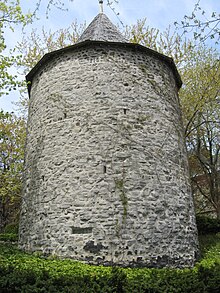| Fort de la Montagne | |
|---|---|
| Montreal, Quebec | |
 Image of fort in front of Collège de Montréal Image of fort in front of Collège de Montréal | |
| Coordinates | 45°29′38″N 73°35′05″W / 45.4938°N 73.5846°W / 45.4938; -73.5846 |
| Type | Fort |
| Site information | |
| Controlled by | New France: Quebec |
| Site history | |
| Built | 1685 |
| In use | 1685-1854 |
| National Historic Site of Canada | |
| Official name | Sulpician Towers / Fort de la Montagne National Historic Site of Canada |
| Designated | 1970 |
| Patrimoine culturel du Québec | |
| Type | Historic monument |
| Designated | 1974 |
The Fort de la Montagne (also called Fort des Messieurs or Fort Belmont) was an old fortification, the remaining structures of which are located on Sherbrooke Street in Montreal, Quebec, Canada. The fort was constructed in 1685 and parts of it were demolished in the mid 19th century. Two 13-metre (43 ft) high stone towers, built in 1694 as bastions of the fort, still remain and are among the oldest structures on the Island of Montreal.
The towers were designated a National Historic Site of Canada in 1970.
History

The mission to Christianize the native people was established in 1675 at the foot of Mont-Royal mountain. François Vachon de Belmont was sent to New France towards 1680 by his superiors, order of Saint-Sulpice priests in Paris to stop the spread of witchcraft and visions at the mission. In 1683, 210 natives, (Iroquois, Hurons et Algonquins) lived on the site. To protect the mission from the Iroquois, a fort was constructed in 1685.
In the two decades of its existence, the brandy trade had increased significantly and the missionaries found it necessary to relocate their neophytes and catechumens farther from the drunkenness and seduction of the cities. In 1696, the inhabitants were moved to the other side of the island, to Fort Lorette at Sault-au-Recollet. The mission at de la Montagne was closed in 1705: the grounds were rented to the local peasants, and some would live in the fortifications. In 1825, a floor is added to the main residence of château des Messieurs and a chapel is built in one of the towers.
The fort contained four bastions and a series of ramparts and palisades, which were all destroyed in 1854 except for the two southern towers, during the building of the College of Montreal.
Three bastions were constructed in the domaine of the Sulpicians: the first when the bastions were built in 1675.
In 1984 to 1986, restoration work was undertaken on the two remaining towers. The towers were classified as provincial historical monuments in 1974. In 1982, the towers were included in the Domaine des Messieurs-de-Saint-Sulpice historic site.
See also
References
- (in French) Chapelle du Grand Séminaire Archived 2012-04-05 at the Wayback Machine, Université du Québec
- Sulpician Towers / Fort de la Montagne National Historic Site of Canada. Canadian Register of Historic Places. Retrieved August 22, 2011.
- (in French) L'implication et l'empreinte des Sulpiciens français à Montréal dès 1657 Archived 2008-05-30 at the Wayback Machine (Concours franco-québécois d'histoires croisées), RÉCIT, mai 1998
- Beaubien, Charles Philippe Trottier de (1898). Le Sault-au-Récollet; ses rapports avec les premiers temps de la colonie; mission - paroisse. Robarts - University of Toronto. Montreal, Beauchemin. pp. 138.
- (in French) Inventaire des lieux de mémoire de la Nouvelle-France Archived 2010-01-24 at the Wayback Machine, Université Laval, 2001-2004
- (in French) Lieux historiques Archived 2010-08-09 at the Wayback Machine, Grand séminaire de Montréal
- Tours du Fort-des-Messieurs-de-Saint-Sulpice. Canadian Register of Historic Places. Retrieved August 22, 2011.
- Domaine des Messieurs-de-Saint-Sulpice. Canadian Register of Historic Places. Retrieved August 22, 2011.
| National Historic Sites of Canada by location | |
|---|---|
| Provinces | |
| Territories | |
| Other countries | |